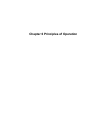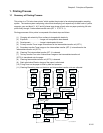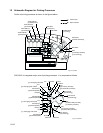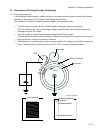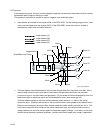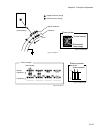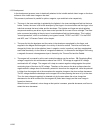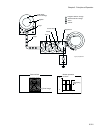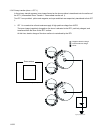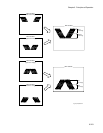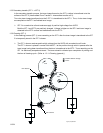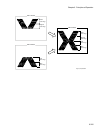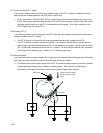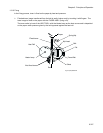6-320
1.3.3 Development
In the development process, toner is electrically attached to the invisible statistic latent image on the drum
surface to form visible toner image on the drum.
This process is performed in parallel for yellow, magenta, cyan and black color respectively.
✧ The toner in the toner cartridge is agitated by the Agitator in the toner cartridge and fed into the toner
holder. Further, the toner is fed to the developer by the Auger in the toner holder and the Auger in the
tube that connects the toner holder and the developer. The Agitator and Auger are spiral agitating
components and they are driven by the toner motor provided on the rear of toner cartridge. The toner
to be consumed according to the print count is calculated and fed into the developer. This is called
"toner dispensation", which is controlled by two types of control, "PCDC" and "ADC". For the PCDC
and ADC, see 7.4 Process Control in this chapter.
✧ The toner fed into the developer and the carrier in the developer are agitated by the Auger, and
supplied to the Magnet Roll arranged in the vicinity of the drum surface. The toner and carrier are
charged by friction due to the agitation (toner in negative, carrier in positive), and they are absorbed
each other electrically. As the carrier is a magnetic substance, it is attracted to the Magnet Roll having
a magnetic force and a homogeneous layer is formed by the Trimmer Rod and the Paddle.
✧ The magnet roll is covered by a thin semi-conductive sleeve over the surface. DB (Developing Bias)
voltage is supplied to this semiconductor sleeve from HVPS. DB voltage is negative DC voltage
combined with AC voltage. The magnet roll is kept at constant negative voltage against the optical
conducting layer of the drum by DC voltage. Therefore, at the area on the drum surface where the
negative electric charge does not decrease, potential is lower than the magnet roll, while the potential
is higher than the magnet roll at the area where the negative charge on the drum surface decreases.
The AC voltage shakes the developer on the magnet roll surface pressing the toner to fly to the drum.
Thus, the toner charged negatively is attracted only by the area where the minus charge has
decreased on the drum surface from the magnet roll (static latent image) and the toner image is
formed on the drum.
When the toner is attached, minus charge at that portion increases, potential decreases, and force to
attract the toner decreases.




